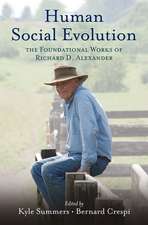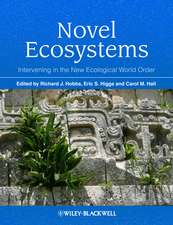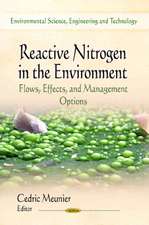Ecological Biogeography of Australia: Monographiae Biologicae, cartea 41
Editat de A. Keasten Limba Engleză Paperback – 23 aug 2014
Din seria Monographiae Biologicae
- 24%
 Preț: 2612.51 lei
Preț: 2612.51 lei - 18%
 Preț: 948.92 lei
Preț: 948.92 lei - 15%
 Preț: 648.74 lei
Preț: 648.74 lei -
 Preț: 397.59 lei
Preț: 397.59 lei - 28%
 Preț: 91.90 lei
Preț: 91.90 lei -
 Preț: 379.86 lei
Preț: 379.86 lei -
 Preț: 388.34 lei
Preț: 388.34 lei -
 Preț: 414.91 lei
Preț: 414.91 lei -
 Preț: 395.47 lei
Preț: 395.47 lei -
 Preț: 389.49 lei
Preț: 389.49 lei -
 Preț: 401.24 lei
Preț: 401.24 lei -
 Preț: 394.71 lei
Preț: 394.71 lei -
 Preț: 405.99 lei
Preț: 405.99 lei -
 Preț: 425.84 lei
Preț: 425.84 lei -
 Preț: 381.21 lei
Preț: 381.21 lei -
 Preț: 389.56 lei
Preț: 389.56 lei - 18%
 Preț: 1833.65 lei
Preț: 1833.65 lei - 18%
 Preț: 1230.35 lei
Preț: 1230.35 lei - 18%
 Preț: 1027.08 lei
Preț: 1027.08 lei -
 Preț: 399.67 lei
Preț: 399.67 lei - 18%
 Preț: 2493.72 lei
Preț: 2493.72 lei -
 Preț: 417.59 lei
Preț: 417.59 lei -
 Preț: 404.89 lei
Preț: 404.89 lei - 20%
 Preț: 557.46 lei
Preț: 557.46 lei -
 Preț: 418.76 lei
Preț: 418.76 lei -
 Preț: 408.37 lei
Preț: 408.37 lei - 15%
 Preț: 650.69 lei
Preț: 650.69 lei - 15%
 Preț: 652.31 lei
Preț: 652.31 lei -
 Preț: 395.37 lei
Preț: 395.37 lei - 18%
 Preț: 1232.26 lei
Preț: 1232.26 lei - 15%
 Preț: 637.59 lei
Preț: 637.59 lei - 18%
 Preț: 1231.95 lei
Preț: 1231.95 lei - 18%
 Preț: 1226.90 lei
Preț: 1226.90 lei - 15%
 Preț: 658.22 lei
Preț: 658.22 lei -
 Preț: 353.75 lei
Preț: 353.75 lei - 18%
 Preț: 1224.36 lei
Preț: 1224.36 lei -
 Preț: 386.22 lei
Preț: 386.22 lei - 15%
 Preț: 652.49 lei
Preț: 652.49 lei - 18%
 Preț: 1228.62 lei
Preț: 1228.62 lei - 18%
 Preț: 945.30 lei
Preț: 945.30 lei - 18%
 Preț: 1231.64 lei
Preț: 1231.64 lei - 15%
 Preț: 633.68 lei
Preț: 633.68 lei - 20%
 Preț: 572.09 lei
Preț: 572.09 lei - 18%
 Preț: 1844.54 lei
Preț: 1844.54 lei -
 Preț: 386.61 lei
Preț: 386.61 lei
Preț: 723.22 lei
Preț vechi: 904.03 lei
-20% Nou
Puncte Express: 1085
Preț estimativ în valută:
138.41€ • 143.96$ • 114.26£
138.41€ • 143.96$ • 114.26£
Carte tipărită la comandă
Livrare economică 10-16 aprilie
Preluare comenzi: 021 569.72.76
Specificații
ISBN-13: 9789400986312
ISBN-10: 9400986319
Pagini: 2212
Ilustrații: LX, 2142 p. 455 illus. In 3 volumes, not available separately.
Dimensiuni: 155 x 235 x 116 mm
Ediția:1981
Editura: SPRINGER NETHERLANDS
Colecția Springer
Seria Monographiae Biologicae
Locul publicării:Dordrecht, Netherlands
ISBN-10: 9400986319
Pagini: 2212
Ilustrații: LX, 2142 p. 455 illus. In 3 volumes, not available separately.
Dimensiuni: 155 x 235 x 116 mm
Ediția:1981
Editura: SPRINGER NETHERLANDS
Colecția Springer
Seria Monographiae Biologicae
Locul publicării:Dordrecht, Netherlands
Public țintă
ResearchCuprins
one: The development of the Australian environment.- 1. The break-up of the Australian-Antarctic segment of Gondwanaland.- 2. The Early Cretaceous break-up of Eastern Gondwanaland, the separation of Australia and India, and their interaction with Southeast Asia.- 3. Tertiary palaeogeography and the evolution of Australian climate.- 4. Late Cainozoic environments in Australia.- 5. Quaternary vegetation and environments.- 6. The environment of Terra Australis.- 7. Fire and the evolution of the Australian biota.- two: The flora of Australia.- 8. Major vegetation formations in Australia.- 9. Ecophysiological principles determining the biogeography of major vegetation formations in Australia.- 10. The history of the phytogeographic region concept in Australia.- 11. The Cretaceous flora.- 12. Tertiary megafossil floras of Australia as indicators of floristic associations and palaeoclimate.- 13. The Tertiary flora.- 14. Origins of the Australian angiosperm flora.- 15. Three old southern families — Myreaceae, Proteaceae and Restionaceae.- 16. Ecological biogeography of Australian conifers and ferns.- 17. Eucalyptus, the universal Australian.- 18. The biogeography of Australian grasses.- 19. The loranthaceous mistletoes in Australia.- 20. Biogeography of halophytic angiosperms (salt-marsh, mangrove and sea-grass).- 21. Lichens.- 22. Australian rainforests: Patterns and change.- 23. The vegetation of the arid zone.- 24. Vegetation of high mountains in Australia.- 25. Phytogeography of southern Australia.- 26. Cytoevolutionary patterns, genetic systems and the phytogeography of Australia.- 27. Evolution of the Australian flora: Some generalizations.- three: The terrestrial invertebrates of Australia.- 28. Australian spiders: Diversity, distribution and ecology.- 29.Eco-evolutionary radiation of Mygalomorph spiders in Australia.- 30. The Scorpions of Australia: Aspects of their ecology and zoogeography.- 31. Historical biogeography of Australian Oligochaeta.- 32. The biogeography and evolution of Australian land snails.- 33. The origin of Lepidoptera relative to Australia.- 34. The geography of the Australian Papilionoidea.- 35. Zoogeography of some Australian Coleoptera as exemplified by the Scarabaeoidea.- 36. Australian Drosophila: Diversity, resource utilization and radiations.- 37. A comparative account of the biogeography of terrestrial invertebrates in Australia: Some generalizations.- four: Biogeography of inland fresh waters.- 38. Inland aquatic systems: An overview.- 39. The Crustacea of Australian inland waters.- 40. Odonata (dragonflies and damselflies).- 41. Plecoptera.- 42. Blephariceridae.- 43. Aquatic and semi-aquatic bugs (Hemiptera) of Australia.- 44. Aquatic insects: An overview.- 45. The distribution of freshwater mussels (Mollusca: Pelecypoda) in the Australian zoogeographic region.- 46. The relationships of Australian freshwater fishes.- five: Biogeography of poikilothermic vertebrates.- 47. The Amphibia: Diversity and distribution.- 48. The Amphibia of mesic Southern Australia: A zoogeographic perspective.- 49. The Australian reptiles: Origins, biogeography, distribution patterns and island evolution.- 50. Diversity and adaptive radiations of Australian desert lizards.- 51. Ecophysiology of Australian desert lizards: Studies on the genus Amphibolurus.- six: Biogeography of homeothermic vertebrates.- 52 A review of the origins and radiations of Australian mammals.- 53 Adaptation of macropod marsupials to aridity.- 54 Rodents — The late invaders.- 55 The biogeography of Australian bats.- 56 The evolutionarybiogeography of Australian birds.- 57 Nectar-feeding and its evolution among Australian vertebrates.- 58 Adjustments of Australian birds to thermal conditions and water scarcity in arid zones.- 59 Species densities of Australian vertebrates.- 60 Cape York Peninsula: Major region of faunal interchange.- seven: Origins and ecology of aboriginal man.- 61 The aborigines: An introduction.- 62 The arrival and adaptation of Australian aborigines.- 63 Prehistory of the Aborigines: Some interesting considerations.- 64 Physiological, demographic and genetic adaptation of Australian Aboriginals.- 65 Hunter-gatherers in a rich environment: Aboriginal coastal exploitation in Cape York peninsula.- 66 Desert aborigines and the southern coastal peoples: Some comparisons.- 67 Integration: Some afterthoughts.- eight: Integration.- 68 Distributional patterns, regional biotas, and adaptations in the Australian biota: A synthesis.- 69 Origins and relationships of the Australian biota.- Systematic index.
Recenzii
`...this work is bound to become the most consulted souce of information for students of southern hemisphere biogeography.'
Acta Botanica Neerlandica, 33:3 (1984)
Acta Botanica Neerlandica, 33:3 (1984)










